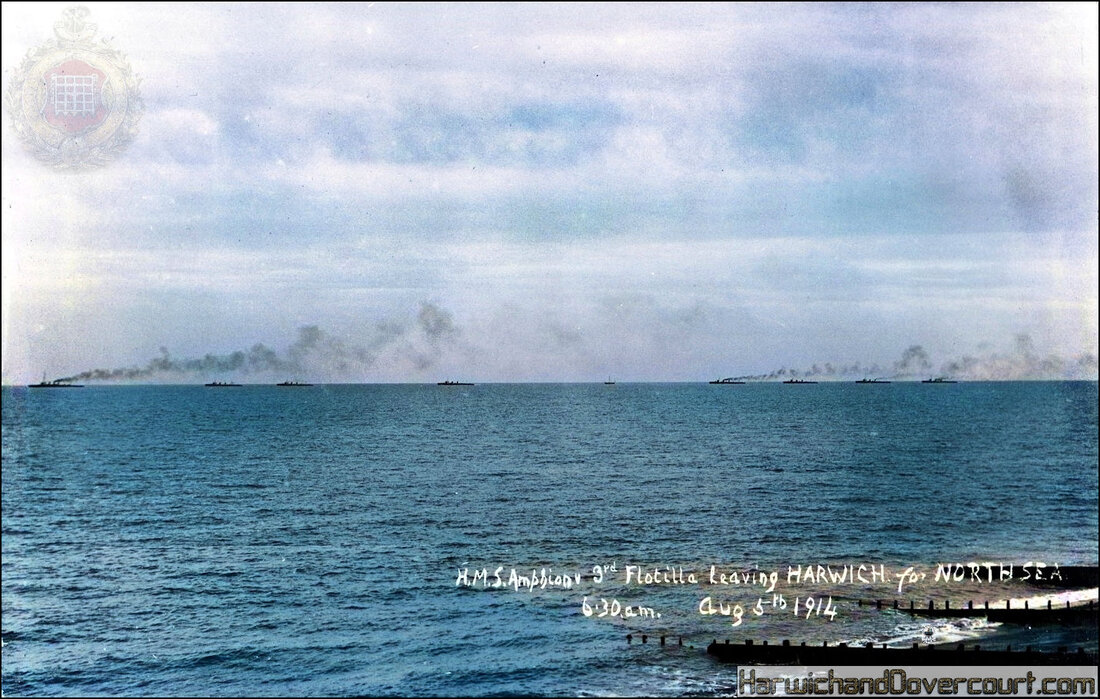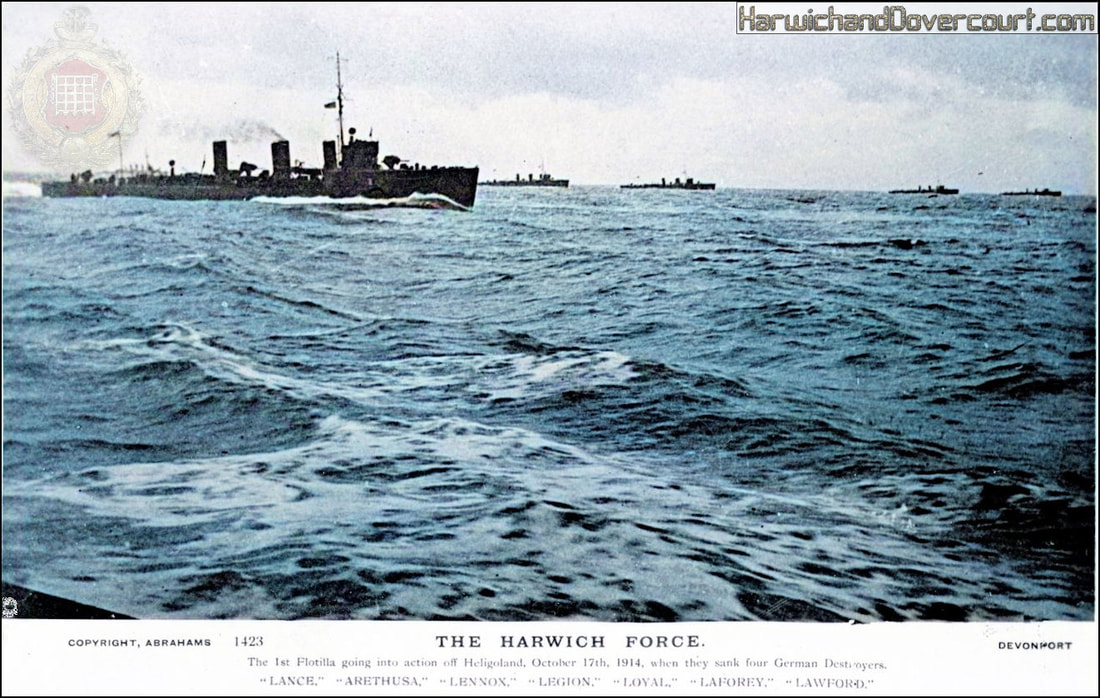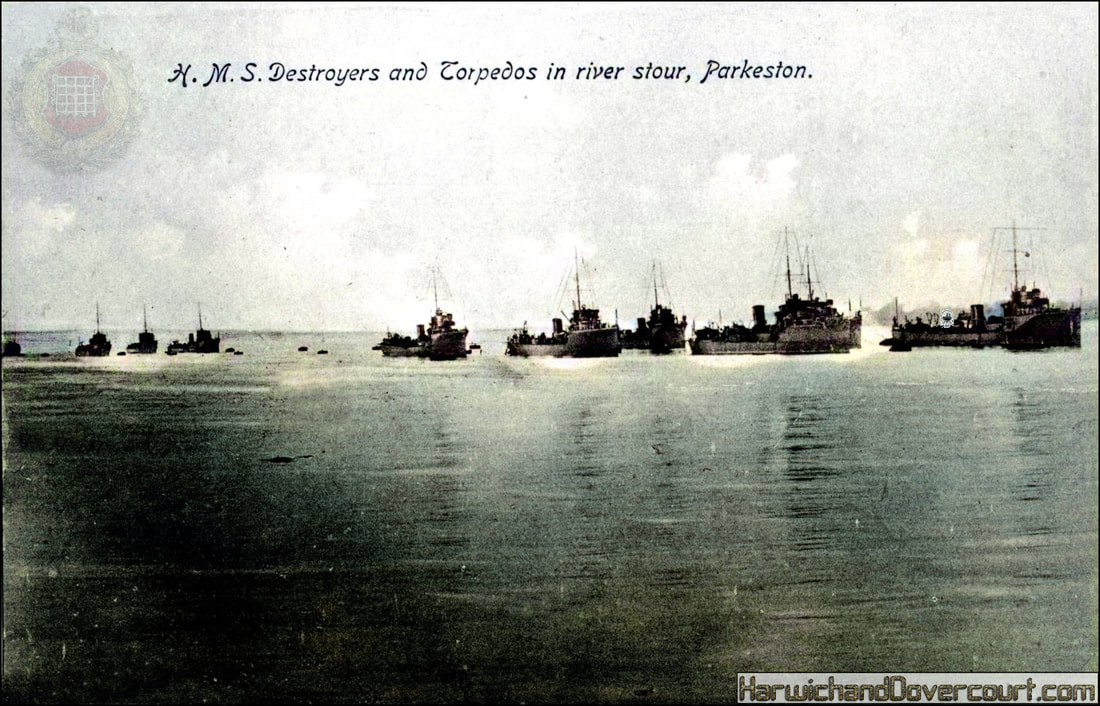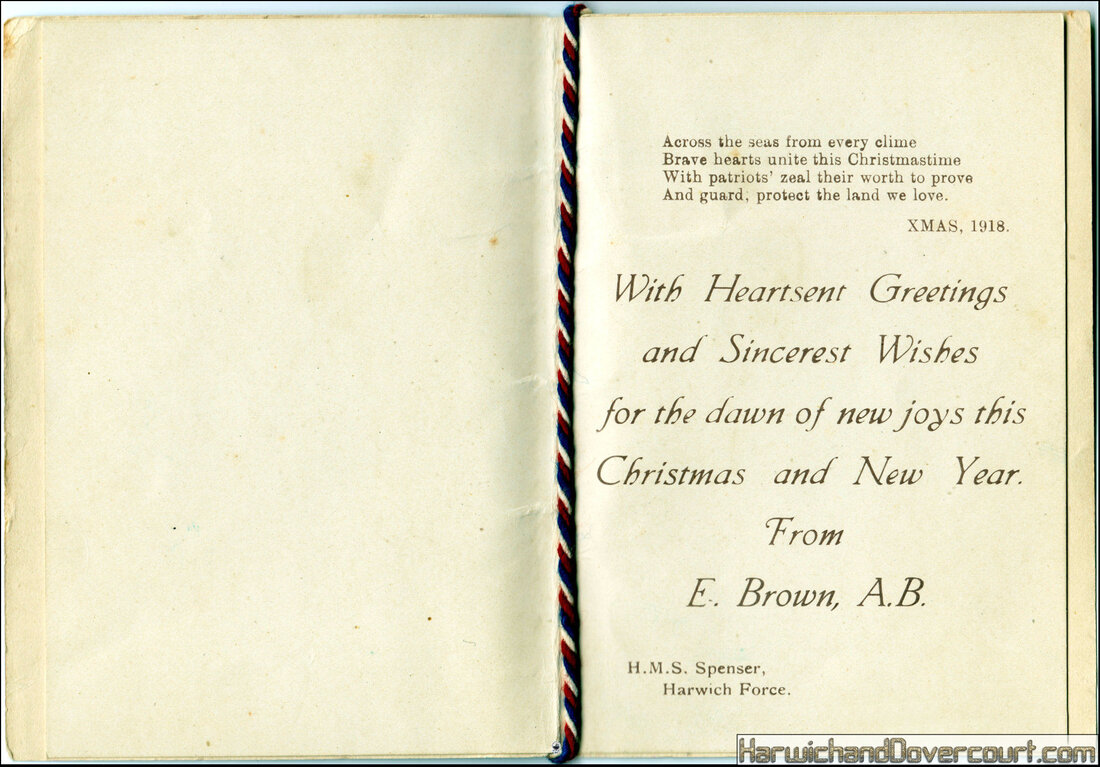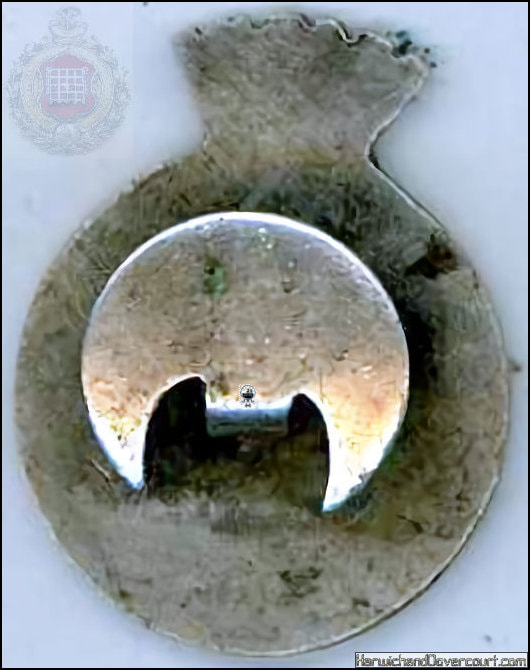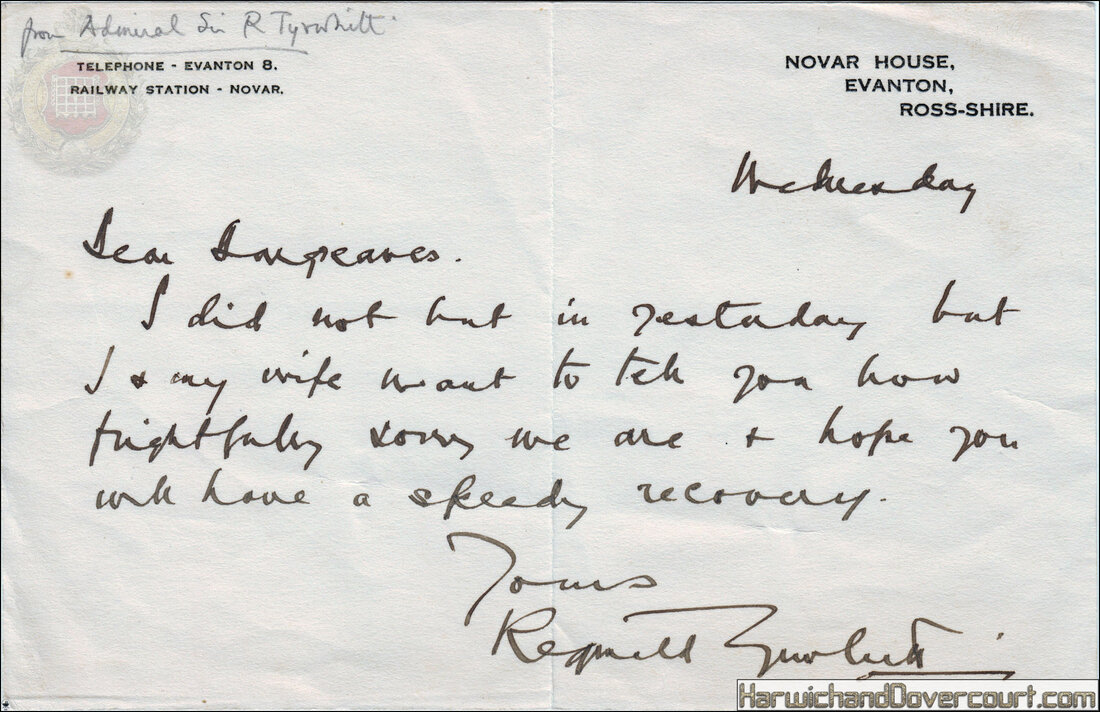1914 - 1919
The Harwich Force was a squadron of the Royal Navy, formed during the First World War and based in Harwich. It played a significant role in the war.
History
After the outbreak of the First World War, a priority for the Royal Navy was to secure the approaches to the English Channel, to prevent elements of the German High Seas Fleet from breaking out into the Atlantic, or from interfering with British maritime trade and convoys to the continent. Most of the major fleet units of the Grand Fleet had dispersed to the navy's anchorage at Scapa Flow or to other North Eastern ports to monitor the northern route from the North Sea into the Atlantic. Consequently, a number of patrol flotillas were organised along the south and east coasts of England, with commands established at several of the major ports in the region. The Dover Patrol was based at Dover, consisting mostly of destroyers, while a number of pre-dreadnoughts and cruisers were based at Portland Harbour. A large number of destroyers, flotilla leaders and light cruisers were centred at Harwich, under the command of Commodore Reginald Tyrwhitt.
Composition
The Harwich Force consisted of between four and eight light cruisers, several flotilla leaders and usually between 30 and 40 destroyers, with numbers fluctuating throughout the war, and organised into flotillas. Also stationed at Harwich was a submarine force under Commodore Roger Keyes.
In early 1917, the Harwich Force consisted of eight light cruisers, two flotilla leaders and 45 destroyers. By the end of the year, there were nine light cruisers, four flotilla leaders and 24 destroyers. The combination of light, fast ships was intended to provide effective scouting and reconnaissance, whilst still being able to engage German light forces, and to frustrate attempts at mine laying in the Channel.
Commanders
Included:
Rear-Admiral Reginald Tyrwhitt, 27 April, 1914 – 1 May, 1919
Rear-Admiral George Holmes Borrett, 1 March, 1919
Service
It was intended that the Harwich Force would operate when possible in conjunction with the Dover Patrol, and the Admiralty intended that the Harwich force would also be able to support the Grand Fleet if it moved into the area. Tyrwhitt was also expected to carry out reconnaissance of German naval activities in the southern parts of the North Sea, and to escort ships sailing between the Thames and the Netherlands. Tyrwhitt's objectives were often complicated by the need to provide reinforcements for the Dover Patrol. The force fired the first shots of the war when a flotilla led by HMS Amphion sank the minelayer Königin Luise on 5 August 1914. During the war, the Force captured or sank 24 enemy merchants, and it escorted 520 eastbound and 511 westbound ships between Dutch and British ports.Their ships also took part in the Cuxhaven Raid on Christmas Day, 1914.
The force was also active in a number of clashes with the Kaiserliche Marine (German Navy). Their ships were present at the Battles of Heligoland Bight, Texel, and Dogger Bank, and were mobilised after the German raids on Scarborough, Hartlepool and Whitby in 1914, and on Yarmouth and Lowestoft in 1916. They were called out during the lead up to the Battle of Jutland, but did not take part in the battle. After the end of the war, Harwich was designated the port at which the remaining German U-boats would be surrendered, and Tyrwhitt's Harwich Force oversaw the operation.
Battle of Jutland
At the end of May 1916, at the time of the Battle of Jutland, the Harwich force consisted of:
5th Light Cruiser Squadron: Carysfort (Commodore Tyrwhitt)
Cleopatra (Captain F. P. Loder-Symonds)
Conquest (Captain Roger Backhouse)
Canterbury (Captain Percy Royds, detached to Grand Fleet)
Penelope (Captain Hubert Lynes; undergoing repairs)
Vindex, a seaplane carrier (detached to Rosyth, Scotland)
9th Destroyer Flotilla light cruiser Undaunted (Capt. Francis G. St.John)
destroyer leader Nimrod
17 (L-class) destroyers (Laforey, Lance, Lark, Lassoo, Laverock, Lawford, Leonidas, Lookout, Loyal, Lysander; detached to the Battlecruiser Fleet: Landrail, Laurel, Liberty, Lydiard; in repairs or refitting: Laertes, Lennox, Lucifer)
10th Destroyer Flotilla light cruiser Aurora (Capt. W. S. Nicholson)
destroyer leader Lightfoot
15 M-class and 3 Talisman-class destroyers. Manly, Mentor, Miranda, Murray, Milne, Myngs; attached to the 3rd Battle Squadron at The Nore: Mastiff, Matchless; detached to the Battlecruiser fleet: Moorsom, Morris, Termagant, Turbulent; in repairs or refit: Melpomene, Medea, Meteor, Trident, Mansfield, Minos.
During the battle, the Harwich Force sortied to join the Grand Fleet on the initiative of Commodore Trywhitt early on 1 June 1916 (although the force was recalled by the Admiralty a few hours later). The following ships were involved:
light cruisers: Carysfort, Cleopatra, Conquest, Aurora, Undauntedflotilla leaders Nimrod, Lightfootdestroyers: 1st Division: Laforey, Lookout, Lawford, Laverock2nd Division: Lance, Lassoo, Lysander, Lark3rd Division: Loyal, Leonidas, Mentor, Miranda4th Division: Manly, Murray, Milne, Myngs.
History
After the outbreak of the First World War, a priority for the Royal Navy was to secure the approaches to the English Channel, to prevent elements of the German High Seas Fleet from breaking out into the Atlantic, or from interfering with British maritime trade and convoys to the continent. Most of the major fleet units of the Grand Fleet had dispersed to the navy's anchorage at Scapa Flow or to other North Eastern ports to monitor the northern route from the North Sea into the Atlantic. Consequently, a number of patrol flotillas were organised along the south and east coasts of England, with commands established at several of the major ports in the region. The Dover Patrol was based at Dover, consisting mostly of destroyers, while a number of pre-dreadnoughts and cruisers were based at Portland Harbour. A large number of destroyers, flotilla leaders and light cruisers were centred at Harwich, under the command of Commodore Reginald Tyrwhitt.
Composition
The Harwich Force consisted of between four and eight light cruisers, several flotilla leaders and usually between 30 and 40 destroyers, with numbers fluctuating throughout the war, and organised into flotillas. Also stationed at Harwich was a submarine force under Commodore Roger Keyes.
In early 1917, the Harwich Force consisted of eight light cruisers, two flotilla leaders and 45 destroyers. By the end of the year, there were nine light cruisers, four flotilla leaders and 24 destroyers. The combination of light, fast ships was intended to provide effective scouting and reconnaissance, whilst still being able to engage German light forces, and to frustrate attempts at mine laying in the Channel.
Commanders
Included:
Rear-Admiral Reginald Tyrwhitt, 27 April, 1914 – 1 May, 1919
Rear-Admiral George Holmes Borrett, 1 March, 1919
Service
It was intended that the Harwich Force would operate when possible in conjunction with the Dover Patrol, and the Admiralty intended that the Harwich force would also be able to support the Grand Fleet if it moved into the area. Tyrwhitt was also expected to carry out reconnaissance of German naval activities in the southern parts of the North Sea, and to escort ships sailing between the Thames and the Netherlands. Tyrwhitt's objectives were often complicated by the need to provide reinforcements for the Dover Patrol. The force fired the first shots of the war when a flotilla led by HMS Amphion sank the minelayer Königin Luise on 5 August 1914. During the war, the Force captured or sank 24 enemy merchants, and it escorted 520 eastbound and 511 westbound ships between Dutch and British ports.Their ships also took part in the Cuxhaven Raid on Christmas Day, 1914.
The force was also active in a number of clashes with the Kaiserliche Marine (German Navy). Their ships were present at the Battles of Heligoland Bight, Texel, and Dogger Bank, and were mobilised after the German raids on Scarborough, Hartlepool and Whitby in 1914, and on Yarmouth and Lowestoft in 1916. They were called out during the lead up to the Battle of Jutland, but did not take part in the battle. After the end of the war, Harwich was designated the port at which the remaining German U-boats would be surrendered, and Tyrwhitt's Harwich Force oversaw the operation.
Battle of Jutland
At the end of May 1916, at the time of the Battle of Jutland, the Harwich force consisted of:
5th Light Cruiser Squadron: Carysfort (Commodore Tyrwhitt)
Cleopatra (Captain F. P. Loder-Symonds)
Conquest (Captain Roger Backhouse)
Canterbury (Captain Percy Royds, detached to Grand Fleet)
Penelope (Captain Hubert Lynes; undergoing repairs)
Vindex, a seaplane carrier (detached to Rosyth, Scotland)
9th Destroyer Flotilla light cruiser Undaunted (Capt. Francis G. St.John)
destroyer leader Nimrod
17 (L-class) destroyers (Laforey, Lance, Lark, Lassoo, Laverock, Lawford, Leonidas, Lookout, Loyal, Lysander; detached to the Battlecruiser Fleet: Landrail, Laurel, Liberty, Lydiard; in repairs or refitting: Laertes, Lennox, Lucifer)
10th Destroyer Flotilla light cruiser Aurora (Capt. W. S. Nicholson)
destroyer leader Lightfoot
15 M-class and 3 Talisman-class destroyers. Manly, Mentor, Miranda, Murray, Milne, Myngs; attached to the 3rd Battle Squadron at The Nore: Mastiff, Matchless; detached to the Battlecruiser fleet: Moorsom, Morris, Termagant, Turbulent; in repairs or refit: Melpomene, Medea, Meteor, Trident, Mansfield, Minos.
During the battle, the Harwich Force sortied to join the Grand Fleet on the initiative of Commodore Trywhitt early on 1 June 1916 (although the force was recalled by the Admiralty a few hours later). The following ships were involved:
light cruisers: Carysfort, Cleopatra, Conquest, Aurora, Undauntedflotilla leaders Nimrod, Lightfootdestroyers: 1st Division: Laforey, Lookout, Lawford, Laverock2nd Division: Lance, Lassoo, Lysander, Lark3rd Division: Loyal, Leonidas, Mentor, Miranda4th Division: Manly, Murray, Milne, Myngs.
01 H.M.S. Amphion 3rd Flotilla Leaving Harwich (1914) Emeny H&D FW
02 3rd Flotilla Entering Harwich Harbour (28 August 1914) FW
03 The Harwich Force (1914) Abrahams H&D FW
04 F54 HMS Sylph Part of the Harwich Force (1916) H&D F
05 Warships In Harwich Harbour (1914) H&D FW
06 H.M.S. Destroyers and Torpedo Boats in river Stour, Parkeston, Essex (1914) H&D FW
Picture 007
Picture 008
09 Sir Admiral Tyrwhitt (1919) Abrahams H&D FW
Sir Reginald Y Tyrwhitt
Admiral of the Fleet Sir Reginald Yorke Tyrwhitt, 1st Baronet, GCB, DSO (10 May 1870 – 30 May 1951) was a Royal Navy officer. During the First World War he served as commander of the Harwich Force. He led a supporting naval force of 31 destroyers and two cruisers at the Battle of Heligoland Bight in August 1914 in which action the 1st Battlecruiser Squadron under Sir David Beatty sunk three German cruisers and one German destroyer with minimal loss of allied warships. Tyrwhitt also led the British naval forces during the Cuxhaven Raid in December 1914 when British sea-planes destroyed German Zeppelin airships and at the Battle of Dogger Bank in January 1915 in which action Tyrwhitt again supported Beatty's powerful battlecruiser squadron.
After the War Tyrwhitt went on to be Senior Naval Officer, Gibraltar, commander of the 3rd Light Cruiser Squadron in the Mediterranean Fleet and then Commander-in-Chief, Coast of Scotland. He also served as Commander-in-Chief, China during a period of disturbances and tension with the Nationalist Government.
His last appointment was as Commander-in-Chief, The Nore.
Admiral of the Fleet Sir Reginald Yorke Tyrwhitt, 1st Baronet, GCB, DSO (10 May 1870 – 30 May 1951) was a Royal Navy officer. During the First World War he served as commander of the Harwich Force. He led a supporting naval force of 31 destroyers and two cruisers at the Battle of Heligoland Bight in August 1914 in which action the 1st Battlecruiser Squadron under Sir David Beatty sunk three German cruisers and one German destroyer with minimal loss of allied warships. Tyrwhitt also led the British naval forces during the Cuxhaven Raid in December 1914 when British sea-planes destroyed German Zeppelin airships and at the Battle of Dogger Bank in January 1915 in which action Tyrwhitt again supported Beatty's powerful battlecruiser squadron.
After the War Tyrwhitt went on to be Senior Naval Officer, Gibraltar, commander of the 3rd Light Cruiser Squadron in the Mediterranean Fleet and then Commander-in-Chief, Coast of Scotland. He also served as Commander-in-Chief, China during a period of disturbances and tension with the Nationalist Government.
His last appointment was as Commander-in-Chief, The Nore.
